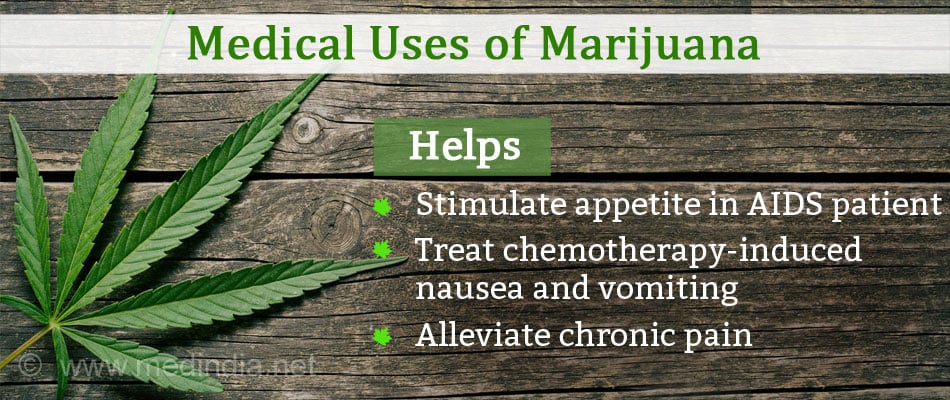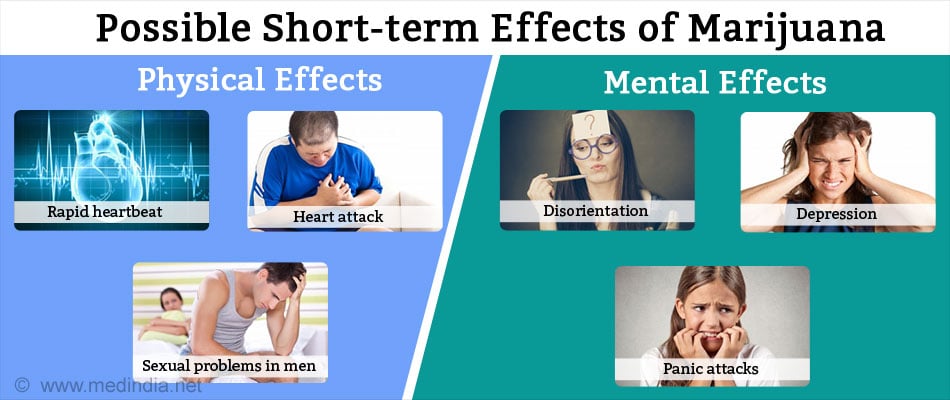- MARIJUANA - (http://www.drugfreeworld.org/drugfacts/marijuana.html)
- What is Cannabis? - (http://learnaboutmarijuanawa.org/factsheets/whatiscannabis.htm)
- Effects of Weed - (http://www.narconon.org/drug-abuse/effects-of-weed.html)
- What is marijuana? - (https://www.drugabuse.gov/publications/drugfacts/marijuana)
- What are psychoactive drugs and how much are they used? - (http://www.greenfacts.org/en/psychoactive-drugs/)
- Marijuana - uses and adverse effects - (https://www.ncbi.nlm.nih.gov/pubmed?cmd=search&term=marijuana+-+uses+and+adverse+effects)
What is Marijuana?
Marijuana in an addictive psychoactive preparation obtained from the female Cannabis plant. The drug substance is found in the flowers, seeds, leaves and stem of the plant. Marijuana refers to the mixture of dried shredded flowers, leaves, stems and seeds from the Cannabis plants. The main mind altering chemical which gives it the intoxicating effect is delta-9-tetrahydrocannabinol (THC).
Marijuana also contains another chemical called CBD (cannabidiol), which is mostly known for its medical benefits. The cannabis plant contains over 500 compounds including more than 100 compounds that are chemically related to THC, called cannabinoids.
Marijuana is used by around 150 million people worldwide as a psychoactive drug for recreational and medical use.
Marijuana is also known by other slang names as weed, pot, grass, bud, and ganja. It has been in use since ancient civilizations for rituals, recreational and spiritual purposes and as an aid to meditation.
What are the different Types of Marijuana?
Marijuana is obtained from the 3 varieties of Cannabis plant:
- Cannabis indica
- Cannabis sativa
- Cannabis ruderalis
Cannabis indica is well-known for its sedative or anti-anxiety effects.
Cannabis sativa have higher levels of THC and known for its cerebral high or uplifting mood effect.
There are many hybrid strains such as sour diesel, blueberry, train wreck and so on which have effects depending on the traits they inherit from their parent strains. There is a huge spectrum of such hybrid strains from the three primary varieties.
Uses of Marijuana
For recreational purpose:
Marijuana is used for a “feel good” and “euphoric” sensation. It can alter the senses, increase appetite and make people feel more relaxed. It may be used initially to experiment, to relieve stress or boredom, to fit in a social circle or as a form of escapism.
For medical reasons:
This refers to the use of marijuana to treat disease or improve symptoms especially in chronic diseases where patients do not respond favorably to conventional treatment.
- In AIDS patients to stimulate appetite
- For chemotherapy-related nausea and vomiting
- To alleviate muscle spasms and chronic pain in multiple sclerosis
- Cancer-related pain not responding to other painkillers

For spiritual purposes:
As an aid to meditation and to connect with one’s inner self. Cannabis has held sacred status in many religious and spiritual practices.
What are the Possible Short-term Side Effects of Marijuana?
Marijuana can have both physical as well as mood effects. The short-term effects include:
- Rapid heartbeat
- Sudden death due to myocardial infarction (heart attack)
- Disorientation
- Lack of physical coordination and impaired movement
- Depression and sleepiness
- Panic attacks and severe anxiety
- Short attention span and memory problems
- Severe mental and emotional impairment, leading to psychotic symptoms such as strange behavior; seeing, hearing or smelling things that aren’t there; fear that one is being watched or followed, not being able to tell imagination from reality
- Impaired judgment, coordination andreaction time, leading to an increased risk of accidents
- Sexual problems in men

Physical Effects:
- Rapid heartbeat
- Heart attack
- Sexual problems in men
Mental Effects:
- Disorientation
- Depression
- Panic attacks
What are the Possible Long-term Effects of Marijuana?
- Chronic bronchitis with symptoms such as coughing, excess sputum and wheezing have been found associated with heavy marijuana smoking.
- Increased risk of lung cancer- Cannabis smoke contains 50% to 70% more cancer causing chemicals (carcinogens) than tobacco smoke. One major research study reported that a single cannabis joint could cause as much damage to the lungs as up to five regular cigarettes smoked one after another.
- Alterations in brain regions such as the hippocampus, prefrontal cortex, amygdala, and cerebellum, which are rich in cannabinoid receptors, thereby altering emotional development and affecting cognition.
- Epidemiological studies have found a strong correlation between cannabis use and the risk of psychosis, the risk of depression and subtle impairments of attention and memory.
- Studies show that the mental functions of people who have smoked a lot of marijuana tend to be diminished. The THC in cannabis disrupts nerve cells in the brain, affecting memory.
- According to scientific studies, the active ingredient in cannabis, THC, remains in the body for weeks or even months. It can cause brain abnormalities similar to those caused by other major drugs. Also, a number of studies show a connection between continued marijuana use and psychosis.
- Marijuana can change the structure of sperm cells causing temporary sterility in men.
- Marijuana use can also disrupt a woman’s menstrual cycle.
- Causes decline in IQ up to 8 points if prolonged use is started in adolescence.
- Leads to poor school performance and higher chance of dropping out.
- Addiction in about 9% of adults and 17% of people who started smoking as teens.
- Responsible for relationship problems and anti-social behavior including stealing or lying.
- Causes financial difficulties with increased dependence on welfare and greater chances of being unemployed or not getting good jobs.
What are the Effects of Marijuana during Pregnancy and Breastfeeding?
- Studies show that women who used cannabis during pregnancy had an increased chance of developing anemia.
- A pregnant woman who regularly smokes marijuana for recreation or to control hyperemesis gravidarum [vomiting during pregnancy] may give birth prematurely to an undersized, underweight baby.

- It may cause abnormal cell division, leading to birth defects and future developmental and hyperactivity disorders in children. There is also increased risk of leukemia in children.
- Infants exposed to cannabis in utero were more likely to be placed in the neonatal intensive care unit.
- Human study shows that marijuana is linked to placental abnormalities and neurodevelopmental deficits.
- THC is passed to the baby through breast milk. For this reason, the American Academy of Pediatrics advices mothers not to use marijuana while breastfeeding. As marijuana is stored in body’s fat cells and requires few weeks to be flushed out, drug effects on the baby are magnified.
How is Marijuana Used?
- By Inhalation. Smoking [marijuana cigarettes, water pipes and hookahs], Vaping [using devices that vaporize the active ingredients in marijuana], Dabbing [waxy concentrate of marijuana is heated to create vapor].
- Orally by swallowing or mixing with food. Liquid extracts are placed or sprayed under the tongue for fast absorption. Beverages such as tea, soda, tonics are infused with marijuana.
- Topical oils that are absorbed through the skin and used for muscle pains.






